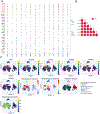Clinical evidence for a role of E2F1-induced replication stress in modulating tumor mutational burden and immune microenvironment
- PMID: 37453246
- PMCID: PMC11847531
- DOI: 10.1016/j.dnarep.2023.103531
Clinical evidence for a role of E2F1-induced replication stress in modulating tumor mutational burden and immune microenvironment
Abstract
DNA replication stress (RS) is frequently induced by oncogene activation and is believed to promote tumorigenesis. However, clinical evidence for the role of oncogene-induced RS in tumorigenesis remains scarce, and the mechanisms by which RS promotes cancer development remain incompletely understood. By performing a series of bioinformatic analyses on the oncogene E2F1, other RS-inducing factors, and replication fork processing factors in TCGA cancer database using previously established tools, we show that hyperactivity of E2F1 likely promotes the expression of several of these factors in virtually all types of cancer to induce RS and cytosolic self-DNA production. In addition, the expression of these factors positively correlates with that of ATR and Chk1 that govern the cellular response to RS, the tumor mutational load, and tumor infiltration of immune-suppressive CD4+Th2 cells and myeloid-derived suppressor cells (MDSCs). Consistently, high expression of these factors is associated with poor patient survival. Our study provides new insights into the role of E2F1-induced RS in tumorigenesis and suggests therapeutic approaches for E2F1-overexpressing cancers by targeting genomic instability, cytosolic self-DNA and the tumor immune microenvironment.
Keywords: Cytosolic self-DNA; E2F1; Replication stress; Tumor immune microenvironment; Tumor mutational burden.
Copyright © 2023 Elsevier B.V. All rights reserved.
Conflict of interest statement
Declaration of Competing Interest The authors declare no conflicts of interest.
Figures









Similar articles
-
Pan-cancer analyses reveal GTSE1 as a biomarker for the immunosuppressive tumor microenvironment.Medicine (Baltimore). 2023 Aug 25;102(34):e34996. doi: 10.1097/MD.0000000000034996. Medicine (Baltimore). 2023. PMID: 37653815 Free PMC article.
-
HER2 Signaling Drives DNA Anabolism and Proliferation through SRC-3 Phosphorylation and E2F1-Regulated Genes.Cancer Res. 2016 Mar 15;76(6):1463-75. doi: 10.1158/0008-5472.CAN-15-2383. Epub 2016 Feb 1. Cancer Res. 2016. PMID: 26833126 Free PMC article.
-
E2F1 in gliomas: a paradigm of oncogene addiction.Cancer Lett. 2008 May 18;263(2):157-63. doi: 10.1016/j.canlet.2008.02.001. Epub 2008 Mar 10. Cancer Lett. 2008. PMID: 18334281 Review.
-
Potential biomarkers of DNA replication stress in cancer.Oncotarget. 2017 Jun 6;8(23):36996-37008. doi: 10.18632/oncotarget.16940. Oncotarget. 2017. PMID: 28445142 Free PMC article. Review.
-
E2F1 facilitates DNA break repair by localizing to break sites and enhancing the expression of homologous recombination factors.Exp Mol Med. 2019 Sep 18;51(9):1-12. doi: 10.1038/s12276-019-0307-2. Exp Mol Med. 2019. PMID: 31534120 Free PMC article.
Cited by
-
Copy number signatures and CCNE1 amplification reveal the involvement of replication stress in high-grade endometrial tumors oncogenesis.Cell Oncol (Dordr). 2024 Aug;47(4):1441-1457. doi: 10.1007/s13402-024-00942-w. Epub 2024 Apr 2. Cell Oncol (Dordr). 2024. PMID: 38564163 Free PMC article.
-
E2F1-induced autocrine IL-6 inflammatory loop mediates cancer-immune crosstalk that predicts T cell phenotype switching and therapeutic responsiveness.Front Immunol. 2024 Oct 31;15:1470368. doi: 10.3389/fimmu.2024.1470368. eCollection 2024. Front Immunol. 2024. PMID: 39544930 Free PMC article.
References
-
- Mazouzi A, Velimezi G, Loizou JI, DNA replication stress: causes, resolution and disease, Exp. Cell Res 329 (2014) 85–93. - PubMed
Publication types
MeSH terms
Substances
Grants and funding
LinkOut - more resources
Full Text Sources
Medical
Research Materials
Miscellaneous

